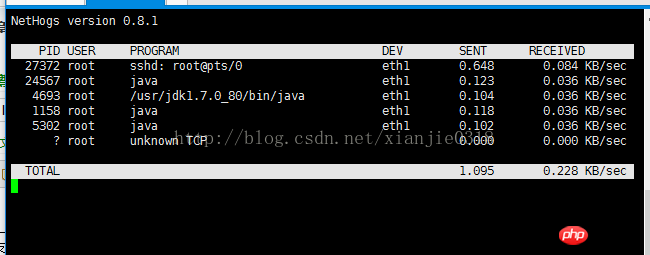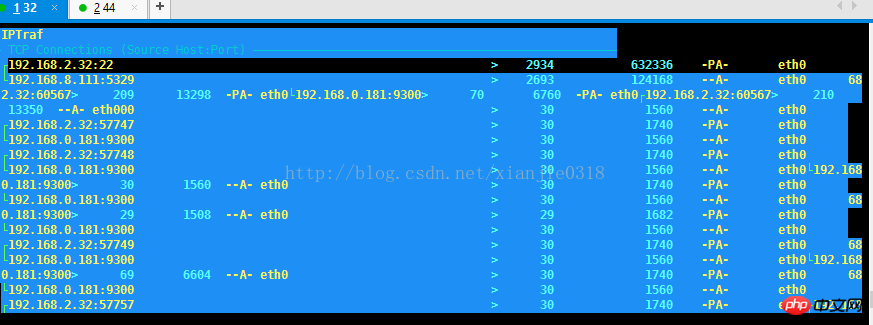 Operation and Maintenance
Operation and Maintenance
 Linux Operation and Maintenance
Linux Operation and Maintenance
 Graphic tutorials on the use of several network traffic monitoring tools under Linux
Graphic tutorials on the use of several network traffic monitoring tools under Linux
Graphic tutorials on the use of several network traffic monitoring tools under Linux
1. nethogs
1) NetHogs is an open source, free, network traffic monitoring tool under the terminal. It can monitor the process or process of Linux Application network traffic. NetHogs can only monitor the network bandwidth usage of the process in real time. NetHogs supports IPv4 and IPv6 protocols, local network cards and PPP links
2) Install under debian
apt- get install nethogs
Install under centos
yum install nethogs
3) Use the command nethogs to view traffic data in real time

View the function nodes corresponding to each process to monitor the amount of network traffic data consumption
4)NetHogs provides interactive control instructions:
m : Cycle between display modes (kb/s, kb, b, mb) Switch the network speed display unit
r : Sort by received. Sort by received traffic
s: Sort by sent. Sort by sent traffic
q: Quit and return to the shell prompt. Exit the NetHogs command tool
2, nload
can monitor in real time The traffic of the network card is divided into two parts: input traffic Incoming and output traffic Outgoing. At the same time, the current, average, minimum, maximum, and total traffic values are counted, and displayed in a dynamic graphic format so that you can see them clearly at a glance
Install apt-get install nload yum install nload
nload

1) iptraf is an IP LAN monitor based on ncurses, used to generate Including TCP information, UDP count, ICMP and OSPF information, Ethernet load information, node status information, IP checksum errors and other statistical data.
Its ncurses-based user interface saves users from remembering tedious command line switches.
Features
IP traffic monitor, used to display IP traffic change information in your network. Includes TCP identification information, packet and byte counts, ICMP details, and OSPF packet types.
Simple and detailed Interface statistics, including IP, TCP, UDP, ICMP, non-IP and other IP packet counts, IP checksum errors , interface activity, packet size counts.
TCP and UDP service monitor, able to display the number of packets sent and received on common TCP and UDP application ports.
The LAN data statistics module can discover online hosts and display statistical information on data activities on them.
Display of TCP, UDP, and other protocols Filters, allowing you to view only the traffic of interest.
Log function.
Supports Ethernet, FDDI, ISDN, SLIP, PPP and local loopback interface types.
Utilizes the raw socket interface built into the Linux kernel, allowing it (referring to iptraf) to be used on various supported network cards
Full screen, menu driven operation.
Real-time viewing via
Navigationmenu
IP traffic monitorGeneral Interface Statistics of the network interface
Details of the network interface Detailed Interface Statistics
Statistical
BreakdownsLAN Station Statistics
Filters...
Configuration( Configure...)
Exit


The above is the detailed content of Graphic tutorials on the use of several network traffic monitoring tools under Linux. For more information, please follow other related articles on the PHP Chinese website!

Hot AI Tools

Undresser.AI Undress
AI-powered app for creating realistic nude photos

AI Clothes Remover
Online AI tool for removing clothes from photos.

Undress AI Tool
Undress images for free

Clothoff.io
AI clothes remover

AI Hentai Generator
Generate AI Hentai for free.

Hot Article

Hot Tools

Notepad++7.3.1
Easy-to-use and free code editor

SublimeText3 Chinese version
Chinese version, very easy to use

Zend Studio 13.0.1
Powerful PHP integrated development environment

Dreamweaver CS6
Visual web development tools

SublimeText3 Mac version
God-level code editing software (SublimeText3)

Hot Topics
 deepseek web version entrance deepseek official website entrance
Feb 19, 2025 pm 04:54 PM
deepseek web version entrance deepseek official website entrance
Feb 19, 2025 pm 04:54 PM
DeepSeek is a powerful intelligent search and analysis tool that provides two access methods: web version and official website. The web version is convenient and efficient, and can be used without installation; the official website provides comprehensive product information, download resources and support services. Whether individuals or corporate users, they can easily obtain and analyze massive data through DeepSeek to improve work efficiency, assist decision-making and promote innovation.
 How to install deepseek
Feb 19, 2025 pm 05:48 PM
How to install deepseek
Feb 19, 2025 pm 05:48 PM
There are many ways to install DeepSeek, including: compile from source (for experienced developers) using precompiled packages (for Windows users) using Docker containers (for most convenient, no need to worry about compatibility) No matter which method you choose, Please read the official documents carefully and prepare them fully to avoid unnecessary trouble.
 BITGet official website installation (2025 beginner's guide)
Feb 21, 2025 pm 08:42 PM
BITGet official website installation (2025 beginner's guide)
Feb 21, 2025 pm 08:42 PM
BITGet is a cryptocurrency exchange that provides a variety of trading services including spot trading, contract trading and derivatives. Founded in 2018, the exchange is headquartered in Singapore and is committed to providing users with a safe and reliable trading platform. BITGet offers a variety of trading pairs, including BTC/USDT, ETH/USDT and XRP/USDT. Additionally, the exchange has a reputation for security and liquidity and offers a variety of features such as premium order types, leveraged trading and 24/7 customer support.
 Ouyi okx installation package is directly included
Feb 21, 2025 pm 08:00 PM
Ouyi okx installation package is directly included
Feb 21, 2025 pm 08:00 PM
Ouyi OKX, the world's leading digital asset exchange, has now launched an official installation package to provide a safe and convenient trading experience. The OKX installation package of Ouyi does not need to be accessed through a browser. It can directly install independent applications on the device, creating a stable and efficient trading platform for users. The installation process is simple and easy to understand. Users only need to download the latest version of the installation package and follow the prompts to complete the installation step by step.
 Get the gate.io installation package for free
Feb 21, 2025 pm 08:21 PM
Get the gate.io installation package for free
Feb 21, 2025 pm 08:21 PM
Gate.io is a popular cryptocurrency exchange that users can use by downloading its installation package and installing it on their devices. The steps to obtain the installation package are as follows: Visit the official website of Gate.io, click "Download", select the corresponding operating system (Windows, Mac or Linux), and download the installation package to your computer. It is recommended to temporarily disable antivirus software or firewall during installation to ensure smooth installation. After completion, the user needs to create a Gate.io account to start using it.
 Ouyi Exchange Download Official Portal
Feb 21, 2025 pm 07:51 PM
Ouyi Exchange Download Official Portal
Feb 21, 2025 pm 07:51 PM
Ouyi, also known as OKX, is a world-leading cryptocurrency trading platform. The article provides a download portal for Ouyi's official installation package, which facilitates users to install Ouyi client on different devices. This installation package supports Windows, Mac, Android and iOS systems. Users can choose the corresponding version to download according to their device type. After the installation is completed, users can register or log in to the Ouyi account, start trading cryptocurrencies and enjoy other services provided by the platform.
 gate.io official website registration installation package link
Feb 21, 2025 pm 08:15 PM
gate.io official website registration installation package link
Feb 21, 2025 pm 08:15 PM
Gate.io is a highly acclaimed cryptocurrency trading platform known for its extensive token selection, low transaction fees and a user-friendly interface. With its advanced security features and excellent customer service, Gate.io provides traders with a reliable and convenient cryptocurrency trading environment. If you want to join Gate.io, please click the link provided to download the official registration installation package to start your cryptocurrency trading journey.
 How to Install phpMyAdmin with Nginx on Ubuntu?
Feb 07, 2025 am 11:12 AM
How to Install phpMyAdmin with Nginx on Ubuntu?
Feb 07, 2025 am 11:12 AM
This tutorial guides you through installing and configuring Nginx and phpMyAdmin on an Ubuntu system, potentially alongside an existing Apache server. We'll cover setting up Nginx, resolving potential port conflicts with Apache, installing MariaDB (





